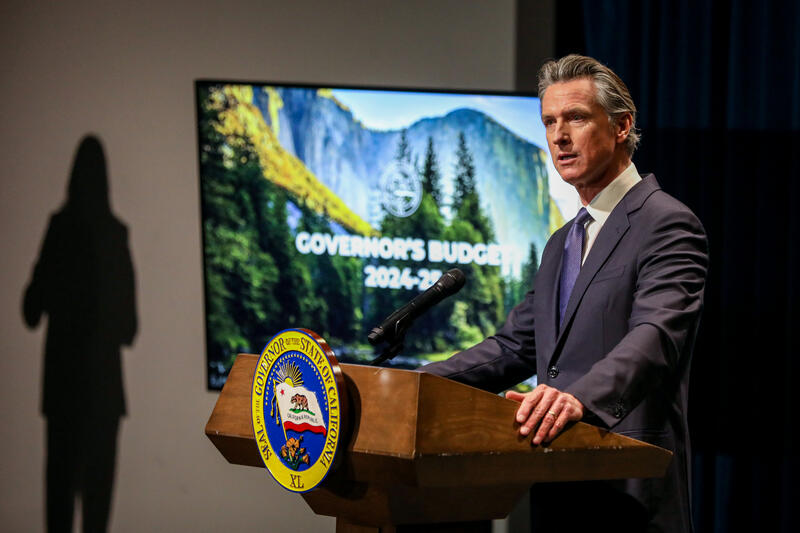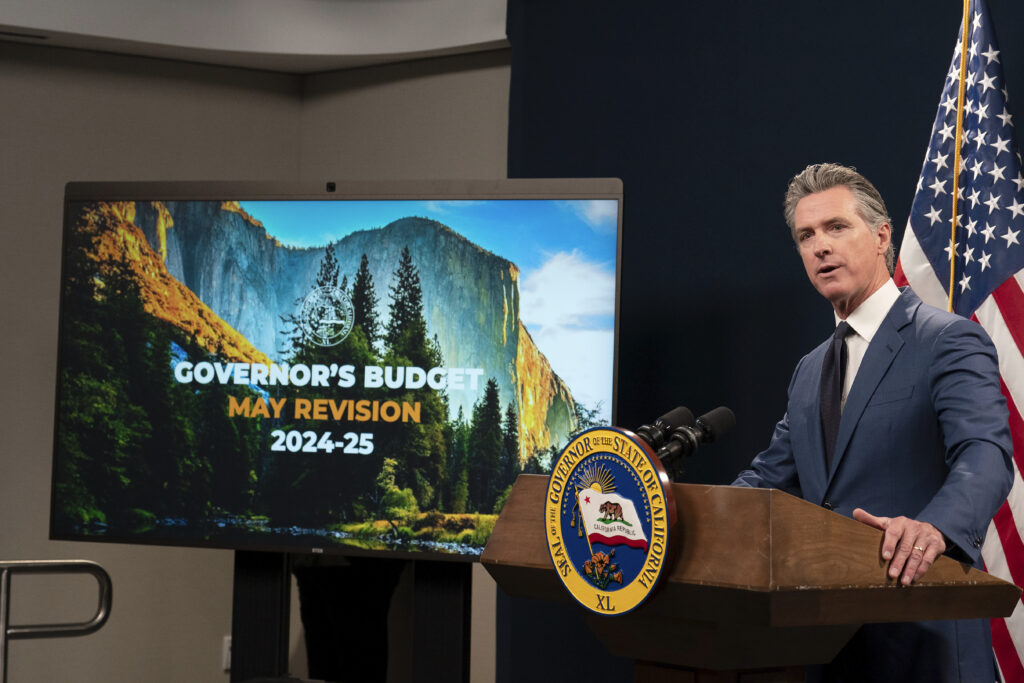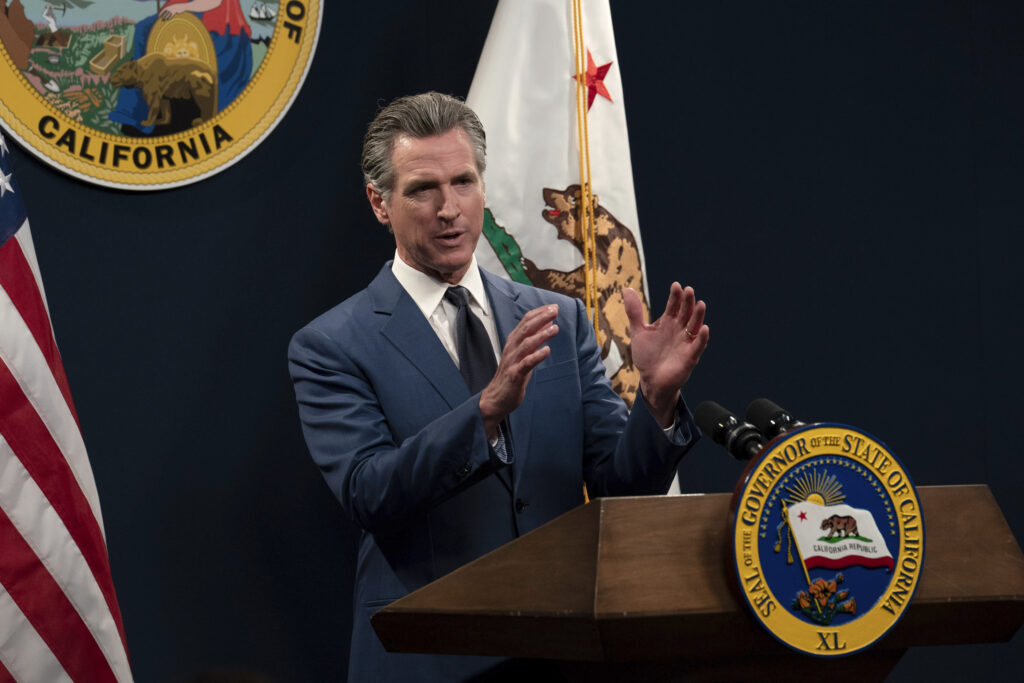
Gov. Gavin Newsom announces his 2024-25 state budget proposal, including his plans to deal with a projected deficit in Sacramento on Jan. 10.. Credit: Brontë Wittpenn / San Francisco Chronicle / Polaris
Gov. Gavin Newsom buoyed the hopes of school district and community college educators this month when, despite a sizable three-year decline in state revenue, he promised to protect schools and colleges from cuts and to uphold future spending commitments.
They might want to hold their applause until after the last act, when the Legislature passes the 2024-25 budget in June.
In an analysis of the state budget, the nonpartisan Legislative Analyst’s Office (LAO) cautioned that there are questions about how Newsom plans to close $8 billion of a huge revenue shortfall facing schools and community colleges.
Beyond meeting this challenge, the LAO also urged legislators to start planning for education spending beyond 2024-25, when flat or declining revenues are expected to raise difficult financial choices. They could pit funding of ongoing expenses against sustaining ambitious programs like summer and after-school programs for low-income students, additional community schools, money for teacher training in early literacy and math, and confronting post-pandemic learning setbacks.
“The state faces significant operating deficits in the coming years, which are the result of lower revenue estimates, as well as increased cost pressures,” the analyst said.
But the immediate enigma is Newsom’s strategy for the $8 billion.
Newsom is projecting that state revenues to run schools and community colleges will be short $14.3 billion over three years: the budget year that ended in 2022-23, the current budget year of 2023-24, and the coming year. That number is calculated as revenue through Proposition 98, the formula that determines the proportion of the state’s general fund that must be spent on schools and community colleges — about 40%.
Proposition 98 revenues are sometimes close but never exactly what a governor and the Legislature assume when they approve a budget. Revenues for the past and current years exceed or fall short of what they projected and not what they predict for the year ahead.
Budget analysts were particularly handicapped when calculating the 2023-24 budget. They didn’t anticipate the shortfall from 2022-23 and didn’t discover it until fall 2023, because of a six-month delay in the filing deadline for 2022 tax returns.
Newsom is proposing to divert $5.7 billion from the Proposition 98 rainy day fund to fill in the current year’s deficit as well as what’s needed to sustain a flat budget, plus a small cost of living increase, for 2024-25. Draining the rainy day fund would require the Legislature’s OK.
The remainder — and biggest piece — is the $9 billion revenue shortfall from 2022-23, which would be $8 billion after other automatic adjustments. That shortfall is technically an overpayment beyond the statutory minimum Proposition 98 funding guarantee. It fell dramatically from what the Legislature adopted in June 2022 to $98.3 billion that revenue actually produced. The biggest decline was in income tax receipts on the top 1% of earners.
School districts have already spent funding from 2022–23, including on staff pay raises that they negotiated with good faith estimates. Newsom and the Legislature could try to deduct that overpayment from the current and 2024-25 budgets, but such a move “would be devastating for students and staff,” Patti Herrera, vice president of the school consulting firm California School Services, told a workshop last week with more than 1,000 school district administrators in Sacramento.
As an alternative, Newsom proposes to find reductions from the non-Proposition 98 side of the general fund, which covers higher education, child care and all other non-education expenses, from prisons to climate change programs.
“We are super grateful there will be no attempts to claw back” the money given to school districts in a past year’s budget, Herrera said.
Newsom’s challenge is to make districts and community colleges financially whole without increasing the minimum Proposition 98 guarantee. Raising Proposition 98 could create a bigger obligation in the future, including potential deficits after 2024-25 — unless the Legislature raises taxes, a nonstarter in an election year.
How Newsom is going to do this is a mystery. The one-sentence reference to it in his budget summary says only, “The Budget proposes statutory changes to address roughly $8 billion of this decrease to avoid impacting existing LEA (school districts) and community college district budgets.”
Both the LAO and School Services said it’s their understanding from the Department of Finance that the payments from the general fund to cover the Proposition 98 overpayment would be made over five years, starting in 2025-26.
“We have some questions about that proposal. Probably the most pressing one is how is the state going to use revenue that it’s not going to collect for several years to address a funding shortfall that exists right now,” said Ken Kapphahn, the LAO’s principal fiscal and policy analyst for TK-12 education.
The questions are legal and political. The proposed statutory language, which may be released in a trailer bill in the coming weeks, will reveal how the state Department of Finance will finesse postponing balancing the 2022-23 budget that’s $8 billion out of kilter. Budget hearings next week in the Capitol may indicate how receptive legislative leaders are to further reducing general fund spending, which also is feeling a financial squeeze.
A search for the extra $8 billion
Additionally, Newsom is proposing several billion dollars of accounting maneuvers that will book spending in 2024-25 but delay and defer payments for programs and some state salaries until early 2025-26. Included are $500 million in deferred reimbursements to the University of California and California State University for the 5% budget increase that Newsom committed to funding in 2024-25.
“Many of these solutions involve moving costs to next year. That is one reason we have the state looking at a large deficit, not just this year, but the following year,” Kapphahn said. “I can’t recall another situation quite like this.”
Barring a recession, which neither LAO nor the Newsom administration is forecasting, both Newsom and the administration are projecting general fund deficits averaging about $30 billion annually in the three years after 2024-25. Pushing the $8 billion solution for the 2022-23 Proposition 98 deficit, along with other general fund delays and deferrals into those years will compound difficult choices, according to the LAO.
“Overall, the governor’s budget runs the risk of understating the degree of fiscal pressure facing the state in the future,” the LAO analysis said.
The LAO suggested other options for resolving the 2022-23 deficit. It recommended applying the remaining $3.8 billion from the Proposition 98 reserve fund that Newsom hasn’t touched and looking for reductions in unallocated one-time funding such as an unused $1 billion for community schools and canceling $500 million for electric school buses.
Even with no cuts to Proposition 98 next year, many school districts and charter schools will likely face their own deficits in 2024-25. That’s because the projected cost-of-living adjustment for next year will not be enough to cover the loss of revenue from declining enrollments. The COLA, tied to a federal formula measuring goods and services bought by state and local governments and not consumer products, is currently projected to be 0.76%; it would be the lowest increase in 40 years, with one exception, the year after the Great Recession, in 2009. This would come on the heels of two years of near record-high COLAs of 6.6% and 8.2%.
The analyst’s office projects the COLA may inch up to 1% by June, when the budget is set. At that rate, a hypothetical school district with 10,000 students would see declining revenues with an enrollment decline of only about 100 students.
Paso Robles Joint Unified School District in San Luis Obispo County, with about 6,000 students, is among those with declining enrollment since the pandemic. As a result, the district, with about 800 full-time employees, anticipates a reduction of five full-time staff members in 2024-25 and perhaps 40 layoff notices the following year, said Brad Pawlowski, the assistant superintendent for business services.
Pawlowski said he came away encouraged after School Services’ presentation that schools will be spared cuts in the next budget, while acknowledging it’s a long time between now and the budget’s adoption.
“We have seen a common message between the governor and the Legislature to protect education. And that does make me feel good,” he said. But doing so, he added, “will mean finding other ways to make that up outside of Prop. 98. That’s going to be the real challenge.”




